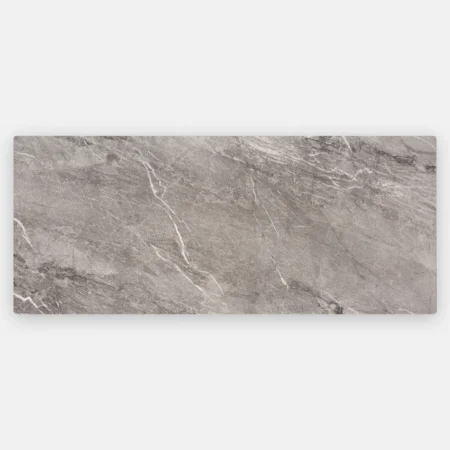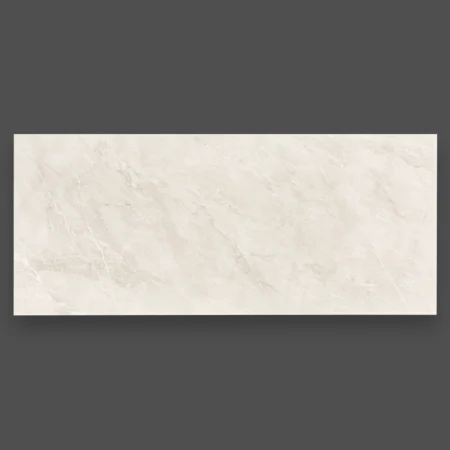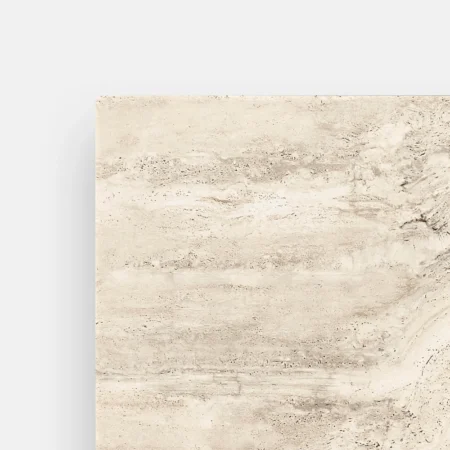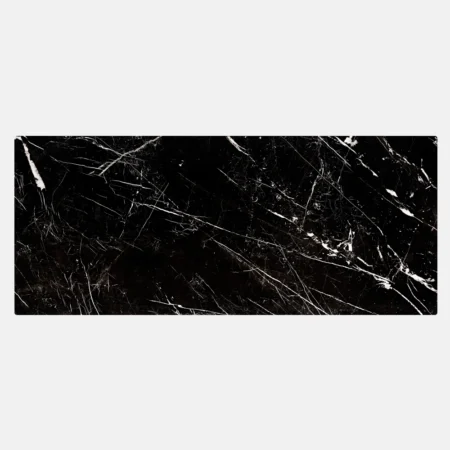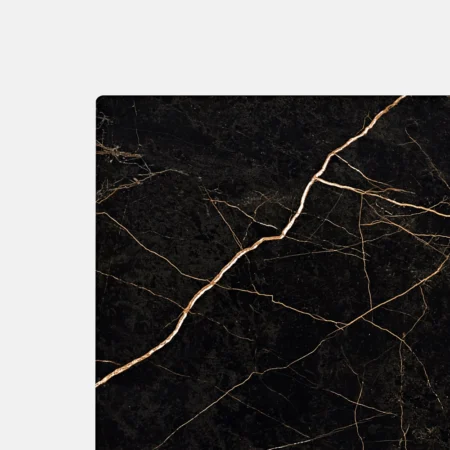Machiavelli Marble, a masterpiece from Italy. This marble features a unique and dramatic veining pattern, characterized by deep brown veins that run through a captivating background of blue-grey. The brown veining provides a sense of warmth and depth to the stone, while the blue-grey backdrop creates a soothing and calming atmosphere.
Large Format Panels
Large format panels have grown in popularity as a choice in contemporary interior design because they provide a number of advantages over conventional tile and flooring choices. These panels can be used in a variety of inventive and unanticipated ways. They are usually larger in size, frequently measuring up to several feet in length and width. Large format panels offer a distinctive aesthetic impact and versatility that make them a popular option for designers and architects equally, from high-traffic commercial spaces to stylish residential homes.
We’ll examine the adaptability of large format panels and some unexpected design uses for them. We’ll examine the various large format panel finishes in more detail, including matte, glossy, and others. We’ll also examine the benefits of using large format panels in high-traffic areas and compare their cost and maintenance requirements to traditional tile and flooring options. This article will give you helpful tips and ideas for incorporating large format panels into your next project, whether you’re a designer, builder, or homeowner.
The Versatility of Large Format Panels: Unexpected Applications in Design
Large format panels are a desirable choice for designers looking for something distinctive and useful due to their versatility. While they are most commonly used as flooring tiles or wall tiles, these panels can also be used in unexpected and unconventional ways. We will look at a few of the unexpected uses of large format panels in design in this part.
Ceilings
A striking ceiling design that gives a room a feeling of depth and texture can be made using large format panels. Designers can produce distinctive and eye-catching ceiling installations that draw attention upward by combining various colors or patterns. Because they are simple to install and keep, large format panels are also an advantageous option for ceilings.
Furniture
Another unexpected application of large format panels is in furniture design. These panels can be used to create custom tables, countertops, and other furniture pieces that offer a sleek and modern look. By using large format panels in furniture design, designers can achieve a seamless and continuous surface that adds a touch of elegance to any space.
Staircases
Large format panels can be used to cover staircases, offering a clean and modern look that is easy to maintain. These panels can be cut to fit the exact dimensions of the stairs, creating a seamless and continuous surface that is both functional and stylish. Using large format panels for staircases is also a practical choice, as the surface is slip-resistant and durable.
Shower Walls
Large format panels can also be used in shower walls, creating a waterproof and low-maintenance surface that is perfect for bathrooms. These panels offer a seamless and continuous surface that eliminates the need for grout lines, making them easy to clean and maintain. Large format panels are also available in a variety of colors and finishes, allowing designers to create a custom look that complements the overall design of the bathroom.
Backsplashes
Large format panels can be used as backsplashes in kitchens, offering a sleek and modern alternative to traditional tile. These panels can be cut to fit the exact dimensions of the wall, creating a seamless and continuous surface that eliminates the need for grout lines. Large format panels are also available in a variety of finishes, including matte, glossy, and textured, making it easy to create a custom look that complements the overall design of the kitchen.
Accent Walls
Finally, large format panels can be used to create striking accent walls that add a bold and dramatic statement to any space. These panels are available in a variety of colors, patterns, and finishes, allowing designers to create a custom look that complements the overall design of the room. Whether used in a residential or commercial space, large format panels are a versatile and unexpected choice for accent walls.
In short, the versatility of large format panels offers designers a range of unique and unexpected applications in design. From ceilings and furniture to shower walls and accent walls, large format panels offer a sleek and modern alternative to traditional tile and flooring options. By using large format panels in unexpected ways, designers can create unique and eye-catching designs that make a lasting impression on anyone who enters the space.
A Closer Look at Large Format Panel Finishes: Matte, Glossy, and More
When it comes to large format panels, choosing the right finish can make a significant impact on the overall design aesthetic. Matte, glossy, and other finishes are available for these panels, each with its own unique benefits and drawbacks. In this section, we’ll take a closer look at these finishes and explore their characteristics and applications in design.
Matte Finishe
Matte finishes have a low-sheen surface and are often preferred for their understated and sophisticated look. This type of finish is great for creating a modern and sleek atmosphere. It is also ideal for areas where natural lighting is limited, as it reduces glare and creates a softer, more comfortable environment. Matte finishes are typically more resistant to fingerprints and smudges, making them a popular choice for high-traffic areas like commercial spaces and public buildings. However, it’s worth noting that matte finishes may require more frequent cleaning than their glossy counterparts.
Glossy Finishe
Glossy finishes are the opposite of matte finishes, offering a highly reflective and polished surface. This type of finish is great for creating a vibrant and high-impact look, especially in areas with ample natural light. Glossy finishes are highly durable and resistant to scratches, making them ideal for high-traffic areas. However, they tend to show fingerprints and smudges more readily than matte finishes, so they may require more frequent cleaning. Glossy finishes can also be slippery when wet, which may pose a safety risk in some environments.
Textured Finishe
Textured finishes are a popular choice for those seeking a more tactile and organic look. This type of finish can add depth and dimension to a design, making it ideal for feature walls and accent pieces. Textured finishes come in a variety of patterns and designs, from subtle ripples to bold, three-dimensional shapes. They can be used to create a sense of visual interest and depth, and can help to soften the overall look of a space.
Polished Finishe
Polished finishes offer a smooth and reflective surface that can add a touch of luxury to any design. This type of finish is often used in high-end residential and commercial projects, as it creates a sophisticated and refined look. Polished finishes are highly durable and easy to clean, making them a popular choice for areas with heavy foot traffic. However, they can be prone to scratching and may require more frequent maintenance than other finishes.
Honored Finishes
Honored finishes are created by combining multiple finishes, such as matte and glossy, to create a unique and customizable look. This type of finish is great for creating a sense of visual interest and depth, as well as for highlighting specific areas of a design. Honored finishes can be used to create a one-of-a-kind look that reflects the unique style and personality of the space and its occupants.
In short, choosing the right finish for your large format panels is an important consideration that can impact the overall aesthetic of your design. Matte, glossy, textured, polished, and honored finishes each offer their own unique benefits and drawbacks, and should be carefully considered based on the needs of your space and the overall design vision. By taking a closer look at these finishes, you can make an informed decision that will help to bring your design vision to life.
The Benefits of Using Large Format Panels in High-Traffic Areas
Large format panels have become a popular choice in high-traffic areas due to their durability and low-maintenance requirements. Here are some of the benefits of using large format panels in high-traffic areas:
Durability
Large format panels are highly durable and can withstand heavy foot traffic, making them an ideal choice for areas such as corridors, lobbies, and retail spaces. Unlike traditional flooring options, large format panels are less likely to crack, chip or scratch, even when subjected to regular wear and tear. This means that they will last longer and require fewer repairs or replacements over time.
Easy Maintenance
Large format panels are relatively easy to clean and maintain. Unlike carpets or other flooring options that can trap dirt and bacteria, large format panels can be easily swept, mopped, or wiped clean. This makes them a popular choice in high-traffic areas where cleanliness is important, such as hospitals, schools, and commercial kitchens. Additionally, some large format panels have antimicrobial properties that help to prevent the growth of bacteria and other harmful microorganisms.
Versatility
Large format panels come in a range of sizes, colors, and finishes, which means they can be used to create a variety of designs and patterns. For example, large format panels can be arranged in a herringbone or chevron pattern to create visual interest and texture. They can also be used to create large, seamless surfaces, which can be especially useful in high-traffic areas where there are fewer seams or grout lines to trap dirt or bacteria.
Cost-Effective
While the upfront cost of large format panels may be higher than some traditional flooring options, their durability and low maintenance requirements make them a cost-effective choice in the long run. Large format panels require fewer repairs and replacements over time, which means that the total cost of ownership is often lower than other flooring options.
Aesthetic Appeal
Large format panels come in a range of colors, patterns, and finishes, which means they can be used to create a wide range of design styles. From sleek and modern to classic and traditional, large format panels can help to create a distinctive look and feel in any space. Additionally, their large size can make them a dramatic statement piece, especially when used in a bold color or pattern.
In short, the benefits of using large format panels in high-traffic areas are clear. They offer durability, easy maintenance, versatility, cost-effectiveness, and aesthetic appeal, making them an ideal choice for a variety of commercial and residential spaces. Whether you’re designing a hospital, school, or retail space, large format panels can help you create a space that is both functional and visually appealing.
From Traditional Tile to Large Format Panels: Comparing Cost and Maintenance
When it comes to flooring options, traditional tile has been a popular choice for decades. However, in recent years, large format panels have emerged as a stylish and versatile alternative. In this section, we’ll compare the cost and maintenance requirements of both options to help you determine which is the best fit for your project.
First, let’s take a look at the cost. Traditional tile flooring is typically less expensive than large format panels, but the cost can vary depending on the type of tile and the installation method. Ceramic and porcelain tiles are the most common types of tile used for flooring, and they typically range in price from $1 to $15 per square foot. However, the cost of installation can add up quickly, especially if the subfloor needs to be leveled or if the tile needs to be cut to fit around corners or obstacles.
On the other hand, large format panels can be more expensive upfront, but they can also be more cost-effective in the long run. Large format panels are typically made of porcelain or natural stone tiles and can cost anywhere from $10 to $30 per square foot, depending on the size and material. However, because the panels are larger, they require fewer grout lines and are quicker and easier to install, which can help offset the higher cost.
When it comes to maintenance, both traditional tile and large format panels require regular cleaning and upkeep. However, there are some key differences to keep in mind. Traditional tile flooring requires regular sealing to protect against stains and moisture, and the grout lines can be prone to discoloration and mildew growth if not cleaned properly. Additionally, individual tiles can crack or chip over time, which can be difficult and expensive to repair.
In contrast, large format panels are less prone to cracking or chipping, thanks to their larger size and thickness. They also have fewer grout lines, which makes them easier to clean and maintain. However, because large format panels are typically made of natural stone or porcelain, they can be more vulnerable to staining and damage from acidic substances. It’s important to use appropriate cleaning products and avoid harsh chemicals that can damage the surface.
In summary, the choice between traditional tile and large format panels ultimately comes down to personal preference and the specific needs of your project. Traditional tile can be less expensive upfront but can require more maintenance and repairs over time. Large format panels can be more expensive upfront, but offer a sleek and modern look and can be more cost-effective in the long run. Ultimately, the decision should be based on your budget, design goals, and maintenance preferences.
Conclusion
In conclusion, large format panels are a versatile and stylish option for a wide range of design applications. Whether you’re looking for a sleek and modern flooring option or a unique way to add texture and interest to a wall, large format panels offer a range of benefits over the traditional tile and other flooring options.
In this blog post, we’ve explored some of the unexpected applications of large format panels, as well as the different finishes available and the benefits of using them in high-traffic areas. We’ve also compared the cost and maintenance requirements of traditional tile and large format panels to help you make an informed decision for your next project.
Ultimately, the choice between traditional tile and large format panels comes down to personal preference, budget, and maintenance needs. However, with their sleek and modern look, durability, and ease of installation, large format panels are certainly worth considering for your next design project. Whether you’re a homeowner, designer, or architect, we hope this post has provided you with valuable insights and inspiration for incorporating large format panels into your design vision.
